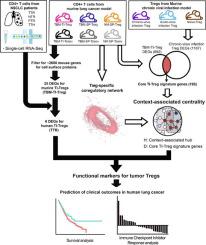Computational and Structural Biotechnology Journal ( IF 6 ) Pub Date : 2021-01-21 , DOI: 10.1016/j.csbj.2021.01.025 Jae-Won Cho , Jimin Son , Sang-Jun Ha , Insuk Lee

|
Regulatory T cells (Tregs) are enriched in the tumor microenvironment and play key roles in immune evasion of cancer cells. Cell surface markers specific for tumor-infiltrating Tregs (TI-Tregs) can be effectively targeted to enhance antitumor immunity and used for stratification of immunotherapy outcomes. Here, we present a systems biology approach to identify functional cell surface markers for TI-Tregs. We selected differentially expressed genes for surface proteins of TI-Tregs and compared these with other CD4+ T cells using bulk RNA-sequencing data from murine lung cancer models. Thereafter, we filtered for human orthologues with conserved expression in TI-Tregs using single-cell transcriptome data from patients with non-small cell lung cancer (NSCLC). To evaluate the functional importance of expression-based markers of TI-Tregs, we utilized network-based measure of context-associated centrality in a Treg-specific coregulatory network. We identified TNFRSF9 (also known as 4-1BB or CD137), a previously reported target for enhancing antitumor immunity, among the final candidates for TI-Treg markers with high functional importance score. We found that the low TNFRSF9 expression level in Tregs was associated with enhanced overall survival rate and response to anti-PD-1 immunotherapy in patients with NSCLC, proposing that TNFRSF9 promotes immune suppressive activity of Tregs in tumor. Collectively, these results demonstrated that integrative transcriptome and network analysis can facilitate the discovery of functional markers of tumor-specific immune cells to develop novel therapeutic targets and biomarkers for boosting cancer immunotherapy.
中文翻译:

系统生物学分析确定TNFRSF9为肿瘤浸润调节性T细胞的功能标记,可预测肺癌的临床结果
调节性T细胞(Tregs)富含肿瘤微环境,并在癌细胞的免疫逃逸中起关键作用。特异于肿瘤浸润Tregs(TI-Tregs)的细胞表面标志物可以有效地靶向增强抗肿瘤免疫力,并用于免疫治疗结果的分层。在这里,我们提出了一种系统生物学方法来识别TI-Tregs的功能性细胞表面标记。我们选择了TI-Tregs表面蛋白的差异表达基因,并将其与其他CD4 +进行了比较T细胞使用来自鼠类肺癌模型的大量RNA测序数据。此后,我们使用来自非小细胞肺癌(NSCLC)患者的单细胞转录组数据过滤了TI-Tregs中保守表达的人类直系同源物。为了评估TI-Treg的基于表达的标记物的功能重要性,我们利用了基于网络的Treg特定调控网络中与情境相关的中心性的度量。在具有高功能重要性评分的TI-Treg标记的最终候选药物中,我们鉴定了TNFRSF9(也称为4-1BB或CD137),这是先前报道的增强抗肿瘤免疫的靶标。我们发现低TNFRSF9Tregs中的表达水平与NSCLC患者的总生存率提高和对抗PD-1免疫疗法的反应有关,这表明TNFRSF9促进了Tregs在肿瘤中的免疫抑制活性。总的来说,这些结果表明整合转录组和网络分析可以促进肿瘤特异性免疫细胞功能标记物的发现,从而开发出新的治疗靶标和生物标记物以增强癌症免疫疗法。


























 京公网安备 11010802027423号
京公网安备 11010802027423号